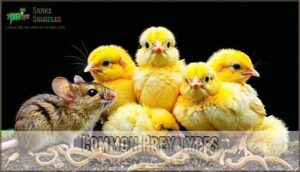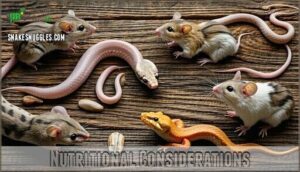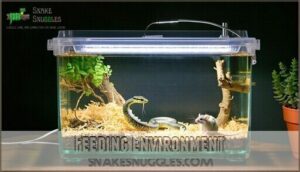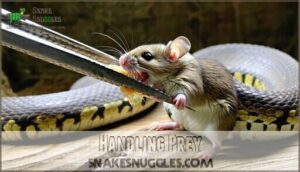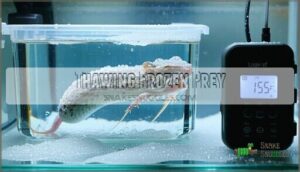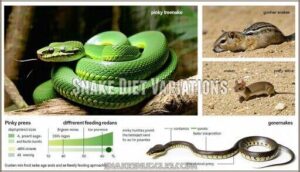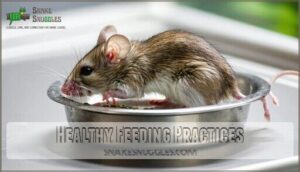This site is supported by our readers. We may earn a commission, at no cost to you, if you purchase through links.
 Your snake’s feeding schedule depends on three key factors: age, size, and species.
Your snake’s feeding schedule depends on three key factors: age, size, and species.
Young snakes under a year old need meals every 5-7 days since they’re growing rapidly. Adult snakes can wait 10-14 days between feedings, while larger species might go 2-3 weeks.
You’ll know you’re on track when your snake maintains steady weight without looking pudgy around the middle. Ball pythons, corn snakes, and king snakes each have slightly different appetites, so don’t panic if your pet doesn’t follow textbook timing.
Watch for signs like active hunting behavior or refusing food—your snake will tell you when it’s ready. The secret lies in reading your specific snake’s unique patterns and adjusting accordingly, which is crucial for understanding your snake’s feeding schedule and recognizing when it’s ready to eat, and this is key to a healthy and thriving pet, by paying attention to its unique patterns.
Table Of Contents
Key Takeaways
- Age determines frequency: Young snakes need to be fed every 5-7 days for rapid growth, while adults can wait 10-14 days between meals as their metabolism slows down.
- Watch your snake’s signals: Look for active hunting behavior, weight changes, and body condition rather than following rigid schedules—your snake will tell you when it is ready to eat.
- Size and species matter: Smaller snakes burn energy faster and need more frequent meals, while larger species like pythons can have their feeding intervals stretched to 2-3 weeks.
- Environmental factors affect appetite: Temperature, shedding cycles, and seasonal changes impact digestion and feeding patterns, so you will need to adjust schedules accordingly.
Snake Feeding Basics
Feeding your snake properly starts with understanding three key factors that determine how often meals are needed.
Your snake’s age, size, and activity level work together to create the perfect feeding schedule that keeps your pet healthy and thriving, based on these factors and their overall impact on the snake’s health.
Feeding Frequency Based on Age
Your snake’s age directly determines its snake feeding frequency.
Baby snakes need meals every other day due to rapid growth, while juveniles require twice-weekly feeding. Adult snakes can wait one to two weeks between meals as their metabolism slows.
Your snake’s age is the biggest clue to how often dinner should arrive.
- Hatchling feeding: Every 5-7 days supports essential early development
- Juvenile snake frequency: Weekly meals maintain steady growth rates
- Mature snake frequency: Bi-weekly feeding matches slower adult metabolism
Feeding Frequency Based on Size
Size directly affects your snake’s feeding schedule through metabolism impact and energy reserves.
Small snakes burn through nutrients quickly, requiring meals twice weekly due to limited storage capacity.
Large snakes can stretch meal intervals to two or three weeks, thanks to efficient energy conservation.
Your snake’s body size determines how often it needs food – smaller species simply can’t go as long between feedings as their larger cousins, which is influenced by energy reserves and overall size.
Feeding Frequency Based on Activity
Your snake’s activity level directly impacts how often you’ll need to feed them.
Active snakes burn more energy and require more frequent meals—typically twice weekly.
Less active snakes need fewer meals due to lower energy expenditure, often eating once weekly.
Their metabolic needs and digestion rate vary with hunting behavior, making activity level a key factor in determining proper snake feeding frequency.
Understanding their needs based on age is also important, so consider age-based feeding schedules, which can help you determine the proper snake feeding frequency and ensure your snake’s overall health and energy expenditure are well-managed, considering their digestion rate.
How Often Feed Snake
Understanding metabolic rate becomes key when determining your snake feeding frequency.
Temperature effects play a major role since snakes are ectothermic creatures whose digestion time varies with environmental conditions.
During cooler periods, prey digestion slows substantially, extending the time between meals.
Remember that prey size matters to avoid health issues.
Your snake feeding schedule should account for these factors:
- Temperature influence – Warmer environments speed up metabolism and reduce digestion time
- Shedding impact – Skip feeding during shed cycles as appetite typically decreases
- Individual variation – Monitor your snake’s body condition and adjust accordingly
- Seasonal changes – Expect appetite fluctuations during breeding seasons or winter months
Most snake diet guides recommend observing your pet’s behavior rather than following rigid schedules.
A well-fed snake shows a slight bulge after eating, then gradually returns to normal girth.
Reptile feeding frequency isn’t one-size-fits-all – you’ll need to adapt based on your snake’s responses and environmental conditions for ideal health.
Choosing Right Prey
Selecting the right prey for your snake isn’t just about size—it’s about nutrition, safety, and species-specific needs that directly impact feeding frequency.
You’ll need to evaluate factors like prey type, nutritional value, and proper sizing to guarantee your snake thrives on its feeding schedule.
Common Prey Types
Variety becomes your feeding arsenal when choosing prey for snakes.
Rodents offer excellent rodent nutrition as staple options, while birds provide essential bird variety for species-specific needs.
Smaller snakes benefit from insect options like earthworms, though amphibian sources require careful selection due to toxins.
Ethical sourcing guarantees safe, parasite-free prey that supports healthy snake feeding frequency and well-being.
Ball pythons, for example, can thrive on rats or even frozen-thawed chicks as alternatives to mice, ensuring a healthy diet.
Nutritional Considerations
When selecting prey types, focus on whole prey for ideal snake nutrition. Fresh rodents deliver balanced nutrient value without requiring vitamin supplements. Most captive snakes thrive on complete prey items that prevent nutritional deficiencies.
Key snake dietary needs include:
- Whole prey provides complete nutrition including bones, organs, and muscle tissue
- Gut loading prey with nutritious foods boosts vitamin content before feeding
- Dietary variety prevents deficiencies – rotate between mice, rats, and appropriate alternatives
- Calcium balance matters especially for fish-eating species requiring supplementation
- Vitamin needs are naturally met through whole prey consumption
Prey Size Guidelines
When choosing prey size, follow the golden rule: never exceed 1.5 times your snake’s widest point.
This Prey Width Ratio guarantees Safe Swallowing and promotes Digestive Health.
Oversized meals can cause regurgitation or serious injuries.
Start hatchlings with pinkie mice, then progress through Size Progression as they grow.
Proper snake food size prevents choking and promotes healthy feeding habits throughout your pet’s life.
Feeding Techniques Matter
Mastering proper feeding techniques will help you avoid common mistakes and keep your snake healthy.
The way you handle prey, create the right environment, and prepare frozen food can make the difference between successful feeding sessions and stressful encounters.
Feeding Environment
Set up your snake’s feeding environment like a stage for dinner success. Create habitat mimicry by using a separate container that reduces feeding stress and prevents your pet from associating its home with mealtime.
Transform your snake’s mealtime into a stress-free dining experience with the right setup.
Control temperature and lighting needs to match natural hunting conditions. Provide privacy by minimizing noise and distractions during supervised feeding, helping your snake feel secure and eat comfortably.
Using tongs is a safe feeding method to avoid bites.
Handling Prey
Safety comes first when handling prey for snake feeding.
Always use feeding tongs to grip prekilled prey, keeping your hands away from your snake’s striking range.
This prevents accidental bites and avoids transferring your scent to the food.
Many owners buy specialized snake tools for this purpose.
Store frozen prey properly in sealed containers to maintain freshness.
When using live feeding as a last resort, supervise closely and make certain prey size matches your snake’s capabilities.
Thawing Frozen Prey
When you’re ready to feed your snake, proper frozen snake food thawing becomes your next priority.
Safe thawing methods protect both you and your pet from harmful bacteria growth.
Thawing Methods for Snake Feeding Safety:
- Refrigerator thawing – Move frozen-thawed prey to fridge overnight for safest temperature control
- Warm water bath – Submerge sealed prey in 100-110°F water for faster thawing time
- Never microwave – Heat distribution damages nutritional impact and creates dangerous hot spots
- Check internal temperature – Prey should feel room temperature throughout before offering to prevent refreezing concerns
- Use within 24 hours – Thawed prekilled prey spoils quickly, requiring immediate feeding or disposal
To guarantee safe thawing, consider using a specialized thawing container.
Snake Diet Variations
Understanding your snake’s unique dietary needs becomes essential as different species, ages, and individual circumstances require customized feeding approaches.
While basic feeding principles apply to most snakes, specific variations in diet composition, frequency, and nutritional supplements can make the difference between a thriving pet and one struggling with health issues, highlighting the importance of understanding dietary needs.
Species Specific Diets
Different snake species have unique dietary preferences that directly impact their feeding schedules.
Ball pythons thrive on rodents every 1-2 weeks, while corn snakes accept mice and small birds weekly.
Boa constrictors need larger prey every 2-4 weeks.
King snakes eat other snakes plus rodents, and garter snakes prefer fish and amphibians multiple times weekly.
Understanding your snake species helps you provide the right diet and is crucial for their feeding schedules.
Dietary Needs by Age
Your snake’s age dictates its nutritional needs like a growing child requires different meals than grandparents.
Feeding baby snake properly sets the foundation for lifelong health, while feeding adult snake focuses on maintenance rather than growth.
- Hatchling Diets: Tiny prey every 5-7 days fuels rapid development
- Juvenile Nutrition: Weekly meals support steady growth spurts
- Adult Feeding: Bi-weekly schedules maintain healthy weight
- Senior Snakes: Monthly feeding prevents obesity in less active animals
- Breeding Needs: Pregnant females require extra nutrition for egg production
Supplementing Vitamins
While proper snake dietary requirements focus on whole prey, vitamin benefits become important when feeding non-whole prey diets.
Supplement types include calcium, vitamin D3, and multivitamins designed for reptiles.
Dosage guidelines vary by species and diet type, and it’s crucial to watch for deficiency signs like shedding problems or soft bones.
Over-supplementing risks include organ calcification and liver issues from excessive snake diet supplementation, so many owners buy reptile vitamin supplements for their snakes.
Healthy Feeding Practices
You’ll master proper feeding schedules by avoiding overfeeding, underfeeding, and feeding during shedding periods when your snake naturally refuses food.
Successful snake care requires regular weight monitoring, watching for feeding refusal patterns, and adjusting meal frequency based on your pet’s age, health changes, and seasonal behavior shifts.
Avoiding Common Mistakes
Many snake feeding mistakes stem from good intentions gone wrong.
Overfeeding Signs include obesity and regurgitation, while Impaction Risks occur from oversized prey.
Avoid Live Prey unless necessary—it’s dangerous.
Temperature Problems affect digestion, so maintain proper heat.
Never feed during Shedding Issues periods.
Common Snake Feeding Mistakes like irregular snake feeding frequency create stress.
Monitor your snake’s behavior and adjust feeding schedules accordingly to prevent snake feeding problems and issues like regurgitation, and ensure proper care to avoid Impaction Risks.
Monitoring Snake Health
Regular health monitoring helps you catch feeding-related issues early.
Watch for shedding patterns, body condition changes, and activity levels that signal problems.
Check your snake’s weight regularly – sudden weight loss or gain affects snake feeding frequency.
Monitor hydration levels and examine fecal matter for parasites.
These simple health checks guarantee your snake weight stays healthy and feeding schedules remain effective and help with feeding frequency and ensure regular health monitoring.
Adjusting Feeding Schedules
Three key factors determine when you’ll need to adjust your snake’s feeding schedule.
Growth monitoring reveals when juveniles slow their development and require less frequent meals.
Seasonal changes affect snake metabolism, with cooler months reducing appetite naturally.
Reproductive status matters too—gravid females need increased nutrition while males may refuse food during breeding season.
Individual variation means some snakes simply eat differently than textbook guidelines suggest.
Common refusal reasons include improper temperatures, stress, or approaching shed cycles.
Watch your snake’s body condition and adjust accordingly rather than rigidly following generic schedules.
This approach allows for a more personalized feeding plan, taking into account the snake’s unique needs and circumstances, including seasonal changes and reproductive status.
Frequently Asked Questions (FAQs)
What happens if snake refuses food?
When your snake turns up its nose at dinner, don’t panic.
Snakes often refuse food during shedding, seasonal changes, illness, stress, or improper temperatures.
Check their environment first, then wait patiently.
Can snakes eat during winter brumation?
During brumation, you shouldn’t feed your snake.
They naturally stop eating and their digestive systems slow down substantially.
Attempting to feed can cause serious health problems, including food rotting in their stomach.
How long can snakes survive without eating?
Adult snakes can survive several weeks to months without eating, while juveniles need food more frequently.
Larger species like pythons can go 6-12 months, but smaller snakes typically require feeding within 2-4 weeks for ideal health.
Should pregnant snakes eat more frequently?
Remarkably, pregnant snakes require up to 50% more calories than usual.
Yes, you should feed pregnant females more frequently—typically weekly instead of every two weeks—until they lay eggs.
Their growing offspring demand extra nutrition for proper development, and it is crucial to provide them with the necessary care, which includes feeding them more frequently.
When do snakes stop eating before shedding?
Most snakes stop eating 5-7 days before they begin shedding. You’ll notice their eyes turn milky blue, skin becomes dull, and they’ll refuse food until the shed’s complete.
Conclusion
Remember the age-old saying "timing is everything"? This holds especially true when determining how often to feed snake companions.
Young snakes require meals every 5-7 days, while adults can wait 10-14 days between feedings. Your snake’s species, size, and activity level will fine-tune this schedule.
Watch for hunting behaviors and weight changes to adjust accordingly. Trust your observations over rigid timelines—every snake develops unique eating patterns that you’ll learn to recognize with experience, and understand that "every snake" is different.


